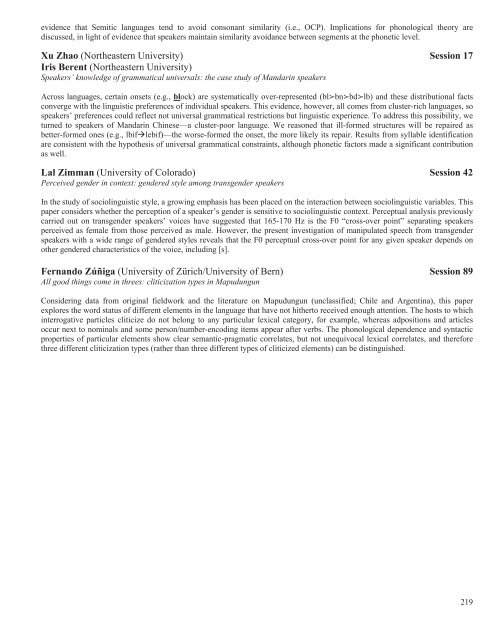here - Linguistic Society of America
here - Linguistic Society of America
here - Linguistic Society of America
Create successful ePaper yourself
Turn your PDF publications into a flip-book with our unique Google optimized e-Paper software.
evidence that Semitic languages tend to avoid consonant similarity (i.e., OCP). Implications for phonological theory arediscussed, in light <strong>of</strong> evidence that speakers maintain similarity avoidance between segments at the phonetic level.Xu Zhao (Northeastern University) Session 17Iris Berent (Northeastern University)Speakers’ knowledge <strong>of</strong> grammatical universals: the case study <strong>of</strong> Mandarin speakersAcross languages, certain onsets (e.g., block) are systematically over-represented (bl≻bn≻bd≻lb) and these distributional factsconverge with the linguistic preferences <strong>of</strong> individual speakers. This evidence, however, all comes from cluster-rich languages, sospeakers’ preferences could reflect not universal grammatical restrictions but linguistic experience. To address this possibility, weturned to speakers <strong>of</strong> Mandarin Chinese—a cluster-poor language. We reasoned that ill-formed structures will be repaired asbetter-formed ones (e.g., lbiflebif)—the worse-formed the onset, the more likely its repair. Results from syllable identificationare consistent with the hypothesis <strong>of</strong> universal grammatical constraints, although phonetic factors made a significant contributionas well.Lal Zimman (University <strong>of</strong> Colorado) Session 42Perceived gender in context: gendered style among transgender speakersIn the study <strong>of</strong> sociolinguistic style, a growing emphasis has been placed on the interaction between sociolinguistic variables. Thispaper considers whether the perception <strong>of</strong> a speaker’s gender is sensitive to sociolinguistic context. Perceptual analysis previouslycarried out on transgender speakers’ voices have suggested that 165-170 Hz is the F0 “cross-over point” separating speakersperceived as female from those perceived as male. However, the present investigation <strong>of</strong> manipulated speech from transgenderspeakers with a wide range <strong>of</strong> gendered styles reveals that the F0 perceptual cross-over point for any given speaker depends onother gendered characteristics <strong>of</strong> the voice, including [s].Fernando Zúñiga (University <strong>of</strong> Zürich/University <strong>of</strong> Bern) Session 89All good things come in threes: cliticization types in MapudungunConsidering data from original fieldwork and the literature on Mapudungun (unclassified; Chile and Argentina), this paperexplores the word status <strong>of</strong> different elements in the language that have not hitherto received enough attention. The hosts to whichinterrogative particles cliticize do not belong to any particular lexical category, for example, w<strong>here</strong>as adpositions and articlesoccur next to nominals and some person/number-encoding items appear after verbs. The phonological dependence and syntacticproperties <strong>of</strong> particular elements show clear semantic-pragmatic correlates, but not unequivocal lexical correlates, and t<strong>here</strong>forethree different cliticization types (rather than three different types <strong>of</strong> cliticized elements) can be distinguished.219
















